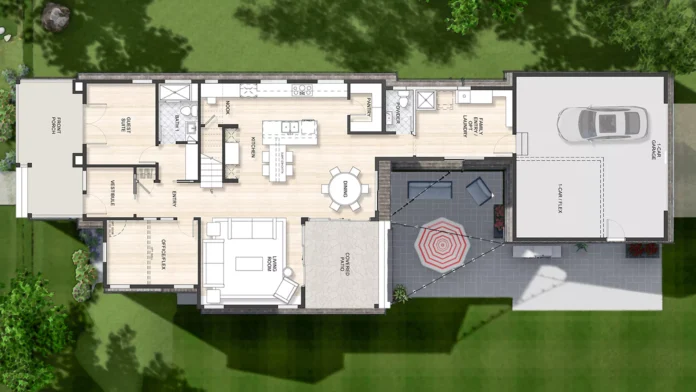(Axios) The pandemic has changed what Americans want from their homes, and builders say they expect those changes to last.
The big picture: A ton of pandemic-era adaptations are becoming common fixtures in new homes. The model homes that builders are showing off today are meant for working, living and learning, not just coming home and crashing at the end of the day.
Details: Big pre-pandemic trends — open plans with big kitchen islands — aren’t going anywhere. “My verdict is that people really like open floor plans, and they’re here to stay,” says Nancy K. Keenan, president of Dahlin Group Architecture and Planning, who helped conduct the America at Home Study of pandemic-era consumer tastes in home design.
- But overall footprints are getting bigger as builders add on more smaller rooms, which may need to function as offices, play rooms, home gyms or dens, depending on the family.
- Bathrooms are getting bigger, in part because we use them more often when we’re home all day. And every room of the house is more wired — builders are adding power outlets and USB ports to accommodate the devices essential to working or attending school from home.
- Some homes also feature separate entrances for guests, with easy access to a powder room for hand-washing.
“Flexibility is probably the most important thing. People want to be able to customize their home to the way they live,” Keenan says.
Flashback: The “powder room” was originally born from the flu pandemic of 1918 — as were tiled bathrooms, as people replaced draperies and carpets that harbored germs.
- ‘The question we get all the time is, how much of this do you think is really going to stick into the future?” Keenan tells Axios. “You don’t realize that this sort of thing actually does create change.”
Zoom in: Based on the results of the America at Home Study, Garman Homes of Raleigh, North Carolina, built a 2,600-square-foot concept home called “Barnaby” that reflects what consumers want, which includes more access to outdoor space and room to exercise.
- Barnaby, with four bedrooms and three-and-a-half baths, was designed for “a hypothetical older millennial family with two working parents, one who works from home and the other outside the home,” per Builder, a home-building news site.
- It includes “separate homeowner and guest entries, two dedicated office spaces, flex spaces, a guest suite with outdoor access, a larger family bathroom, multiple covered outdoor spaces, improved kitchen functionality, flexible storage, drop zones for package deliveries, and more.”
Between the lines: “Homes are becoming more like office space,” says Amit Haller, CEO and co-founder of the homebuilding company Veev. “There is the grand opening area with a very large countertop island that allows people to eat together.”
- From there, residents can carry their laptops to private rooms as needed.
- “The bedroom is going to be literally like your conference room and your private space,” Haller says.
By the numbers: The median size of a new single-family home has already grown by about 10% since 2009, and will likely keep growing.
- More than a third of Millennials (36%) want larger homes as a result of the pandemic, a survey by the National Association of Home Builders (NAHB) found.
- Millennials and Gen Xers want more bedrooms, exercise rooms and home offices.
- “The home building industry expects to see home sizes continue to increase due to a shift in consumer preferences as more activities are taking place in the home in the post-pandemic environment,” NAHB Chairman Jerry Konter said in a press release.
Yes, but: Bigger houses are more expensive, and high interest rates will only make a mortgage even harder to afford.
What’s next: Dedicated rooms are popping up for video games, golf simulators, Zoom calls or relaxation — so called “Zen rooms.”
- “Metaverse rooms” may be on the horizon, with some designers seeing the need for indoor space where people can wander around in virtual reality, per the Wall Street Journal.
Comments on this article: New homes will be more expensive for today’s homebuyer but the Residential Building Code change in Pennsylvania and new building materials are making the home more affordable, safe and healthy to live in over time. With much of the housing stock over 30 years old, the subject of cost to maintain, heat & cool, effects of water penetration and ignoring safety items/regular maintenance items are not typically discussed at the time of purchasing a home.
The main concern when purchasing a home tends to be:
- What is the sales price and what do I need to offer in order to get it?
- Can I get a mortgage and what will the payment be?
- Should we wave the home inspection contingency, so our offer is more attractive?
What should be discussed is:
- How much is it going to cost to maintain this home and/or how much is it going to cost to make up for the lack of maintenance?
- How much is it going to cost to heat and cool this home?
- How has water penetration affected the health of the home and what safety features need to be installed?
These are matters that will affect you once you have purchased the home. (Comments written by Don Minehart as a member of the Sharon St.Clair Real Estate Team at eXp Realty)










